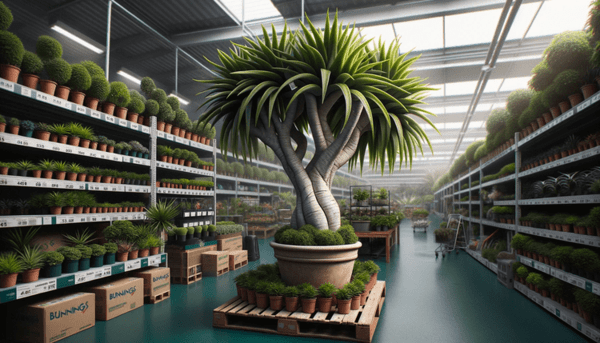
dragon tree
Information for the customer:
- Plant Position: indoor
- Soil Type: well draining , porous
- Watering Needs: low-moderate: anytime between weekly and monthly
- Shade Requirements: yes
- Lighting Requirements: average light: 50% - 75% of daily sun
- Pet Child Friendly: no
- Air Purifying: yes
Potting Sizes and Info:
- Maximum Growing Height: 120cm
Additional Facts and Info:
- Scientific Name: dracaena
Extensive Info on the dragon tree:
How do you take care of a Dracaena?
Location
The Dracaena thrives best with indirect sunlight to partial shade. Place it somewhere where direct sunlight does not hit this indoor plant, as it can burn its leaves. If it is placed in a room with less light, it will still survive. When the Dracaena is positioned in a place with a lot of partial shade, the plant will feel fine but will slow down in growth.
Watering
Before watering the Dracaena, check if the soil feels dry. The plant only needs water if the soil is dried out first. Overwatering can cause the plant to grow fungus or make the roots start to rot. If possible, use distilled water or filtered water for the Dracaena, as minerals and salts in unfiltered water or tap water can cause the tips of the leaves to turn brown.
Plant nutrition
The Dracaena doesn't use a lot of energy. However, the plant likes extra nutrients in the growing season. You can provide these nutrients by using plant nutrition. We recommend giving plant nutrition once every month, from spring until autumn. After autumn and in winter, it is better not to give extra nutrients, as plant nutrition during that time can be harmful to the Dracaena.
Repotting
Repotting the Dracaena isn't necessary every year. The plant is a slow grower. We recommend repotting the Dracaena every 2 years. Repotting gives the plant new nutrients and more room for root growth. The airier soil is also very good for water flow. The best period to repot is spring.
Air-purifying
The Dracaena plays a role as an air purifier. Dracaena plants can clean the air of chemicals like xylene, formaldehyde, and benzene, which is one reason people prefer them for their homes.
Is the Dracaena toxic?
The Dracaena leaves are toxic to cats and dogs because they contain toxic alkyds. If chewed by pets, these leaves can cause diarrhea, drooling, mouth irritation, swelling in the face, and other symptoms.
Diseases and peculiarities
If the air is too dry, the Dracaena can suffer from spider mites. To prevent spider mites, it is best to use a plant sprayer once a week. Spider mites are an infection of mites on plants, and you can recognize the infection by infected leaves and a kind of cobwebs. If you come across spider mites, it is best to place the plant outside, as wind and moisture from outside will quickly keep the spider mites away.
Frequently asked questions about the Dracaena
Why are the leaves of my Dracaena turning yellow?
Yellow leaves can have different causes. The leaves of the Dracaena can turn yellow because of too much light, although this doesn't happen very often. The most common reason for yellow leaves on Dracaena is too much water. If the leaves of the Dracaena turn yellow and even droop, this is caused by too much water. Let the soil dry out before watering the plant again. It is wise to check if there is no stem- or root rot.
Why are the leaves of my Dracaena curling?
The leaves of a Dracaena usually curl because they are dehydrated. In this case, give it a little more water in the coming period.
How big can a Dracaena get?
In nature, Dracaenas can grow to a height of 12 meters. As an indoor plant, the plant will not reach this height, but 3 meters should be possible.
Can you propagate a Dracaena?
Yes, you certainly can. Check out our tips on how to propagate the Dracaena.